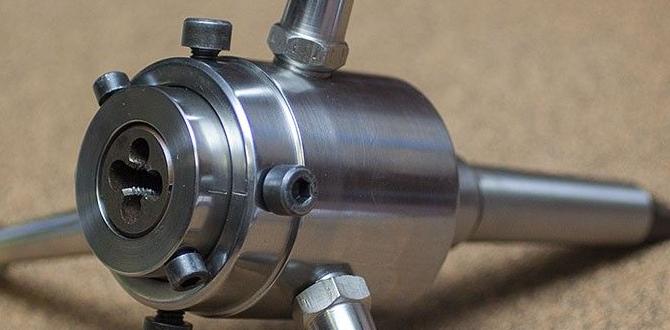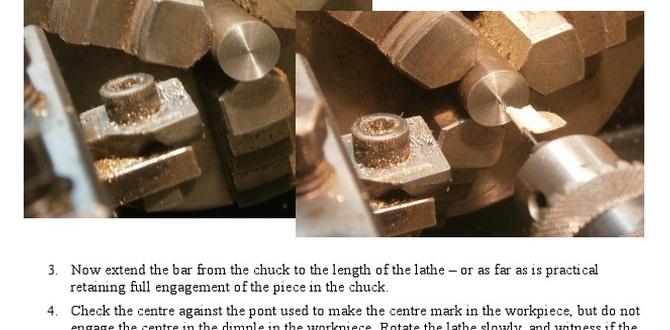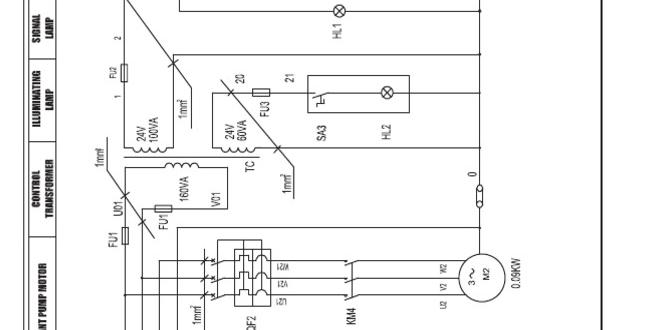A TIALN ball nose end mill is a game-changer for machining Inconel 718, offering superior heat resistance and edge retention to tackle this notoriously tough superalloy, especially for deep slotting applications.
Working with superalloys like Inconel 718 can feel like trying to carve granite with a butter knife. It’s tough, it’s gummy, and it loves to eat standard cutting tools for breakfast. Many machinists shy away from it, but that doesn’t have to be your story. What if I told you there’s a specific tool that makes difficult Inconel machining significantly easier? Enter the TIALN ball nose end mill. Specifically designed to handle the extreme challenges of materials like Inconel 718, this end mill is like a secret weapon for your milling machine. We’re going to break down exactly why it’s so brilliant and how you can start using it confidently for those tricky deep slotting jobs.
Why Inconel 718 is a Machining Headache (And How TIALN Helps!)
Inconel 718 is a marvel of modern engineering. It’s a nickel-chromium-based superalloy that retains its strength at incredibly high temperatures, making it ideal for jet engines, rocket motors, and high-performance industrial applications. But all that strength comes at a machining cost. It work-hardens rapidly, meaning the more you cut it, the harder the area you’re cutting becomes. This leads to excessive tool wear, chatter, and poor surface finishes with conventional tooling.
This is where specialized tooling becomes not just beneficial, but essential. The TIALN coating (Titanium Aluminum Nitride) on a ball nose end mill offers a unique advantage in this battle:
- Extreme Hardness: TIALN coatings are incredibly hard, helping them resist the abrasive nature of Inconel 718 and its tendency to chip away at cutting edges.
- High Heat Resistance: Machining generates a lot of heat. Inconel 718 exacerbates this. TIALN can withstand much higher temperatures than uncoated carbide, allowing for faster cutting speeds and longer tool life before signs of thermal degradation appear on the cutting edge.
- Reduced Friction: The coating creates a smoother surface on the cutting tool, which reduces friction between the tool and the workpiece. Less friction means less heat buildup and less tendency for material to stick to the cutter – a common problem with gummy materials like Inconel.
- Oxidation Barrier: TIALN forms a protective aluminum oxide layer at high temperatures, which acts as a diffusion barrier and further enhances thermal stability. This is crucial when working with materials that generate significant heat.
The Genius of the Ball Nose Design for Deep Slots
Now, let’s talk about the “ball nose” part of the equation, especially when you’re aiming to cut deep slots. A ball nose end mill has a hemispherical tip, meaning the cutting edge is a perfect half-sphere. This shape is incredibly versatile, but for deep slotting, it offers specific advantages:
- Contoured Machining: The rounded tip allows you to mill complex shapes and contours effortlessly. For deep slots, this means you can plunge directly into the material and start cutting without needing a separate ramping or plunging operation with a different tool.
- Reduced Stress Concentration: Unlike a square-shouldered end mill, the radius at the tip of a ball nose end mill distributes cutting forces more evenly. This is vital when plunging deep, as it helps prevent premature tool breakage.
- Achieving Radiused Bottoms: Often, deep slots in Inconel are designed with a radiused bottom for structural integrity or to avoid stress points. A ball nose end mill inherently creates this radiused bottom with a single tool, simplifying your machining process.
- Helical Interpolation: This is a very effective technique for creating slots and pockets. With a ball nose end mill, you can use a helical path to enter the material, gradually clearing out material in a smooth, continuous motion. This reduces shock loads on the tool and improves chip evacuation, both critical for superalloys.
Why a 35-Degree Helix Angle Specializes for Inconel 718
You might see “35-degree helix angle” mentioned with TIALN ball nose end mills for Inconel 718. This specific angle is not arbitrary; it’s a carefully chosen design feature that contributes to its effectiveness:
- Optimized Chip Evacuation: A 35-degree helix angle provides a good balance between effective chip ejection and maintaining cutting edge strength. For sticky materials like Inconel, efficient chip removal is paramount. If chips aren’t cleared, they re-cut, generating more heat and rapidly dulling the tool. The helix angle helps spiral those chips up and out of the flutes.
- Reduced Cutting Forces: A moderate helix angle like 35 degrees helps to reduce the axial forces experienced during plunging and ramping. This makes it easier for your milling machine to handle the cut and reduces the risk of chatter, which is a major enemy of tool life and surface finish.
- Improved Surface Finish: The angle of the flutes influences how the cutting edge engages the material, affecting the surface finish. A well-designed helix angle can lead to a smoother, more consistent finish, which is often critical for Inconel components.
- Bridging the Gap: Steeper helix angles (like 45 degrees or more) are excellent for high-speed machining and chip evacuation but can sometimes be too aggressive and lead to chatter in gummy materials. Shallower helix angles (like 20-30 degrees) offer more rigidity but less effective chip removal. The 35-degree angle strikes a favorable balance specifically for the challenging characteristics of Inconel 718 and similar alloys, especially when dealing with deeper cuts.
Choosing the Right TIALN Ball Nose End Mill for the Job
Not all TIALN ball nose end mills are created equal. When selecting one for Inconel 718, keep these factors in mind:
| Feature | Consideration for Inconel 718 | Why it Matters |
|---|---|---|
| Material Grade | High-quality, micrograin carbide is preferred. | Provides a strong foundation for the TIALN coating and resists chipping. |
| Coating Thickness & Quality | Ensure it’s a reputable TIALN coating, applied evenly. | A thin or porous coating won’t offer the full benefits against heat and abrasion. Look for manufacturers with a strong track record. |
| Number of Flutes | Typically 2 or 4 flutes. 2 flutes are often preferred for Inconel. | Fewer flutes offer better chip clearance in gummy materials, reducing the risk of recutting chips and overheating. 4 flutes can offer more rigidity at higher feed rates but require excellent chip evacuation. |
| Helix Angle | 30-35 degrees is often ideal. | As discussed, balances chip evacuation, cutting forces, and tool rigidity for Inconel. |
| Corner Radius | Match to your application’s required slot corner radius. | Ensures you achieve the desired geometry without needing secondary operations. |
| Tool Diameter | Choose a diameter suitable for your slot width. | For deep slots, consider a slightly smaller diameter than the slot for adequate clearance, or use smaller step-overs. |
| Shank Features | Consider a Weldon shank for secure clamping. | Prevents the end mill from being pulled out of the collet under heavy cutting loads. |
Setting Up Your Machining Parameters for Success
Even with the best tooling, improper machining parameters can lead to disaster. Inconel 718 demands a conservative yet effective approach. These are general guidelines, and you should always consult your tool manufacturer’s recommendations and test for your specific setup.
Speeds and Feeds: The Delicate Balance
Finding the sweet spot for cutting speeds and feed rates is crucial. Too fast a spindle speed (RPM) or too high a feed rate can lead to rapid tool wear, chatter, or breakage. Too slow, and you might not be cutting efficiently, leading to work hardening.
- Surface Speed (SFM/SMM): Start conservatively. For TIALN coated carbide end mills in Inconel 718, you might begin in the range of 25-50 SFM (Surface Feet per Minute) or 8-15 SMM (Surface Meters per Minute). This is significantly lower than what you’d use for aluminum or mild steel.
- Chip Load (IPR/MMT): This is the thickness of the chip being removed by each cutting edge. A good starting point for a 1/4″ (6mm) diameter end mill might be around 0.001″-0.002″ IPR (Inches Per Revolution) or 0.025-0.05 MMT (Millimeters Per Tooth). The total feed rate (FR) is calculated by: FR = Chip Load x Number of Flutes x RPM.
- Depth of Cut (DOC) and Width of Cut (WOC): For deep slotting, aggressive depths of cut are rarely advised. Start with a shallow DOC, perhaps no more than 0.5 times the tool diameter. For WOC, small step-overs (e.g., 20-40% of the tool diameter) are often necessary to avoid overloading the tool and ensure good chip management in sticky Inconel. This is where the ball nose excels, allowing you to mill a slot “out” with smaller step-overs.
Pro Tip: Always aim for a continuous chip. If you hear squealing or see uneven chip formation, adjust your parameters. It’s better to be slow and steady and get the part done reliably.
Coolant and Lubrication: Your Best Friend
Inconel 718 machining generates immense heat. Without proper cooling and lubrication, your TIALN end mill will overheat, lose its coating’s effectiveness, and quickly fail. You absolutely need a robust coolant system.
- Flood Coolant: A generous flood of high-pressure coolant is essential. This not only cools the cutting zone but also helps to flush chips away from the tool.
- MQL (Minimum Quantity Lubrication): For some operations, MQL systems can be effective, delivering a fine mist of lubricant directly to the cutting edge. However, for Inconel, the cooling effect of flood coolant is often more critical.
- Cutting Fluid Type: Use a cutting fluid specifically formulated for machining difficult-to-cut alloys. These fluids often have high lubricity and excellent cooling properties. Consult your supplier for recommendations.
A great resource for understanding machining basics, including speeds and feeds, is the NIST Machining Handbook, though it can be quite technical. For simpler guidance, many tool manufacturers provide downloadable calculators or charts.
Tool Holding Rigidity
A weak tool holding system will lead to chatter and tool breakage, especially when working with tough materials like Inconel. Ensure:
- High-Quality Collets/Tool Holders: Use precision-ground collets or tool holders. A Runout of less than 0.0005″ (0.013mm) is highly desirable.
- Shank Engagement: Make sure the end mill shank is securely clamped in the tool holder. If using a Weldon shank, ensure the set screw is properly tightened.
- Machine Rigidity: Your milling machine needs to be rigid and well-maintained. Loose ways, a wobbly spindle, or an underpowered machine will fight you every step of the way with Inconel.
Step-by-Step: Milling Deep Slots with a TIALN Ball Nose End Mill
Let’s walk through a typical scenario for cutting a deep slot in Inconel 718 using your TIALN ball nose end mill. Safety first – always wear safety glasses and follow your machine’s operating procedures.
-
Program or Set Up the Toolpath
A. CAM Programming: If you’re using CAM software, define your slot geometry. Select your TIALN ball nose end mill as the tool. Specify the desired Slot Depth (Z), Slot Width (X/Y), and tool parameters. The software will calculate the necessary step-overs and cutter paths. Ensure you set appropriate entry points (like helical interpolation if possible).
B. Manual Programming/Operation: If you’re operating manually, you’ll need to carefully control the machine’s movements (or set up G-code). Plan your path to ensure you maintain depth and width consistently. For plunging, you’ll want to enter the material at a shallow angle or use a controlled dive.
-
Secure the Workpiece
Ensure your Inconel 718 workpiece is securely fixtured. Use clamps or a vise that can withstand the cutting forces without shifting. Misalignment or movement here is a recipe for disaster.
-
Set Up Your Tool in the Spindle
Install your TIALN ball nose end mill into a clean tool holder and then into your machine’s spindle. Ensure it’s seated correctly and tightened appropriately.
-
Set Your Tool Length Offset
Accurately set the Z-axis tool length offset. This is critical for controlling the cutting depth. Use a tool setter or a carefully controlled manual method.
-
Establish Speeds, Feeds, and Coolant
Based on your research and the guidelines above, set your spindle speed (RPM), feed rate (IPM or MM/min), and coolant flow. Double-check all parameters before initiating the cut.
-
Initiate the Cut (Plunging/Entry)
For deep slots, a direct plunge can be aggressive. If your machine and CAM software support it, consider using helical interpolation. This involves entering the material in a circular path, gradually lowering the tool. If direct plunging, do so slowly and with ample coolant. Ensure your chip load is appropriate for plunging.
-
Milling the Slot
Allow the tool to carve out the slot. Monitor the cutting process closely. Listen for unusual noises (chatter, rubbing), watch for excessive vibration, and observe chip formation. If anything seems amiss, stop the machine immediately.
For deep slots: You will likely need to make multiple passes, incrementally increasing the depth of cut until your final desired depth is achieved. This is crucial to avoid overloading the tool, managing heat, and ensuring good chip evacuation. A common strategy is to mill 75-90% of the final depth in one or more passes, then finish with a final pass. Work width (step-over) should also be controlled, especially in your first passes.
-
Final Depth and Finishing
Once you reach the target depth, you might perform a final pass with a very light depth of cut to achieve a better surface finish if required. The ball nose end mill will naturally create a radiused bottom.
-
Tool Inspection
After the operation, inspect your end mill. Look for signs of excessive wear, chipping, or heat discoloration. This will help you refine your parameters for future Inconel 718 machining jobs.
Remember, practice makes perfect. Start with lower parameters and gradually increase them as you gain confidence and observe the tool’s performance.
Benefits of Using TIALN Ball Nose End Mills for Inconel 718
The advantages of employing this specialized tooling for Inconel 718 are numerous:
- Increased Tool Life: Significantly longer tool life compared to standard end mills, leading to fewer tool changes and reduced downtime.
- Improved Surface Finish: The combination of the TIALN coating and the ball nose geometry helps produce smoother, more consistent surface finishes.
- Reduced Machining Time: While you’ll start with conservative parameters, better chip control and heat management allow for more aggressive cutting strategies as you optimize, leading to faster overall cycle times.
- Cost Savings: Although initially more expensive, the improved performance and extended tool life often result in lower overall machining costs per part.
- Enables Difficult Geometries: Ideal for creating complex 3D shapes, radiused pockets, and deep contoured slots that would be very difficult or impossible with other tooling.
- Reduced Scrap Rates: Better tool stability and predictable performance lead to fewer errors and less wasted material.
When to Consider Alternatives (Or Enhance Your Strategy)
While TIAL








